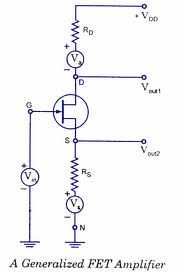FET amplifier

An FET amplifier is an amplifier which uses one or more field-effect transistors (FETs). The main advantage of an FET used for amplification is that it has very high input impedance and low output impedance. These are two desirable features for an amplifier.
In detail
The transconductance is given by,
gm=Id/Vgs
On rearranging we get,
Id=gm*Vgs ...(1)
Thus, from this equation we can tell that output current Id is product of input voltage Vgs and the transconductance gm.[1]
Equivalent circuit
A FET equivalent circuit is given by equation number (1). The internal resistance r'gs, between gate and source and a current source given by equation (1) appears between drain and source. r'ds is internal resistance between drain and source. As r'gs is very high, it is taken to be infinite and r'ds is neglected. [1]
Voltage Gain
For ideal FET equivalent circuit, voltage gain is given by,
Av=Vds/Vgs
From the equivalent circuit,
Vds=Id*Rd
and from the definition of transconductance,
Vgs=Id/gm
Thus we get,
Av=gm*Rd ...(2) [1]
Types of FET amplifiers
There are three types of FET amplifiers depending upon the common terminal used as input and output. This is similar to a bipolar junction transistor (BJT) amplifier.
Common Gate Amplifier
In a Common gate amplifier, the gate terminal is common to both input and output.
Common Source Amplifier
In a Common source amplifier, the source terminal is common to both input and output.
Common Drain Amplifier
In a Common drain amplifier, the drain terminal is common to both input and output. It is also known as a 'Source Follower'. [2]